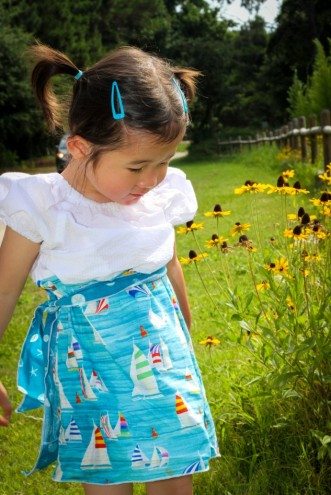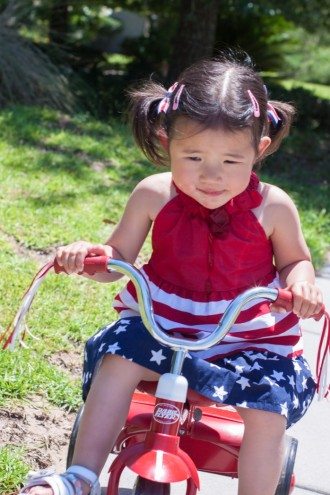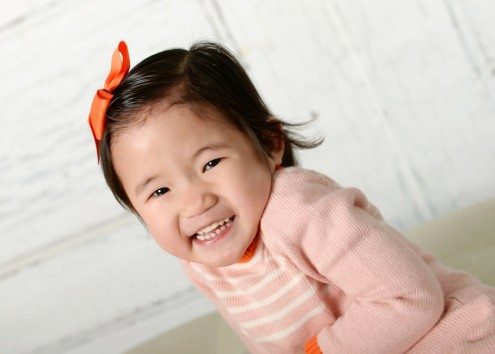In May of 2013, we were asked if we wanted to review the file of a little girl with a repaired Congenital Heart Defect, Tetralogy of Fallot (TOF). We had been waiting several months and were so ready for THE phone call. When our doctor reviewed the file, she told us about Velo Cardio Facial Syndrome (22q11.2 Deletion Syndrome) because approximately 15-20% of TOF cases are caused by the syndrome. We did a little research and always had it in the back of our minds that it was a possibility. Once we arrived home, we started to hit all of our medical appointments, pediatrician, cardiology and then finally, the chromosome test was ordered (FISH & Microarray). We had started to think the possibly was very strong. We got the call and the test was positive for the syndrome.
ˈsinˌdrōm noun a group of symptoms that consistently occur together or a condition characterized by a set of associated symptoms
That really doesn’t sound that scary does it? Oh, but the stigma that comes with that word! The good natured sympathetic, “I’m so sorry” and “You are so strong,” comments can sometimes really have the opposite effect and make you feel awful. As Full Plate Mom says about her daughter, “she is not something we handle. She’s not a burden we shoulder. She’s not something we overcome. She’s a little girl. A little girl we CHOSE to adopt. There are no guarantees in adoption. There are no guarantees in life. You get a diagnosis. You grieve. You search out the best answers. And then, you fight. You fight because…she’s worth as much as any other child, and that’s what we would do for any child.” Yes, exactly!
What is my daughter’s syndrome? It goes by many names but the most current medically accurate is 22q11.2 Deletion Syndrome (22q). What is 22q? First, let’s start off by saying typically children and adults with the 22q11.2 deletion do quite well both medically and as members of their families and communities at large. Most are married, have children, jobs and live a “normal” life.
22q.11.2 is the most common multiple anomaly disorder in humans that is caused by a microdeletion of DNA present from the time child is conceived. It is known by a number of names, including, Velo Cardio Facial Syndrome, DiGeorge syndrome, conotruncal anomalies face syndrome, Sedlačková syndrome, and more recently, 22q11.2 deletion syndrome. Nearly 200 distinct symptoms are associated with 22q. Although 1 in every 2000 people in the U.S. has 22q, this is still considered to be a rare disease and highly underdiagnosed. No two people are ever exactly alike, even when they have the same syndrome, and not every person with the deletion is affected in the same way. Though not always present, the key characteristics of this syndrome include combinations and varying degrees of:
• heart defects
• palate differences
• feeding and gastrointestinal difficulties
• immune system deficits
• growth delay
• kidney problems
• hearing loss
• low calcium and other endocrine issues
• cognitive, developmental and speech delays
• behavioral, emotional, and psychiatric differences (ADHD, autism, anxiety, etc.)
Every child born with 22q presents the possible 180 symptoms in a way that are unique to him or her. Many times, this scattered collection of issues impedes the proper diagnosis for years. Geneticists, cardiologists, and ENT’s have only recently begun to recognize just how often these common issues can be directly attributed to this partial deletion of the 22nd chromosome.
The syndrome presents in a spectrum and some people are highly affected and experience many symptoms. Others may exhibit few symptoms and may go undiagnosed their entire life or until they have a child who has the syndrome.
After the diagnosis was confirmed for our daughter, I reached out to some other moms who shared great advice with me. ‘Don’t get overwhelmed with the “what if” and the future or you just might miss out on how amazing your child is right now!’ And, ‘take it one appointment and one medical need at a time.’ I think these are great pieces of advice for anyone parenting a child with complex special needs.
I may never truly have the diagnosis “out of my head” but when I am with my daughter, I see the amazing girl she is, I don’t think about 22q at all. It does NOT define her. I still chose not to share her diagnosis with many people besides teachers and doctors. There is a fear that others will choose to define her via a Google search before letting her have the chance to do it herself.
So far the symptoms Ashlyn has exhibited of the possible 180 include an extra bone in her thumbs, TOF, speech delays and small stature. She exhibits fewer symptoms than some children who have not been diagnosed with a syndrome at all. Who is Ashlyn? She’s a silly, happy, strong willed, determined, sweet, funny, loving, stubborn, shy, willing to learn, observant (a bit of a tattletale), and just plain adorable little girl. None of that is a symptom, it’s all HER and she’s amazing! Our daughter may have a tiny missing piece but she certainly makes us feel complete.
Other symptoms may present in the future and she is monitored annually through the 22q Clinic at our local Children’s Hospital. In a strange way that allows me to wrap my head around the possible list of symptoms. I know that some will never happen and others are a ‘wait and see’ but at least I know what to look for and why it is happening.
Many families who adopted children from China with this diagnosis did not know it ahead of time. They were mostly given genetic tests or diagnosed by a doctor after arriving home. Most of us China 22q families have children that have TOF or a cleft palate and even some came from the non-special needs program. If you suspect your child may have 22q or any genetic syndrome, request a FISH or Microarray chromosome test. The Microarray is more accurate as there have been cases of the FISH test missing the micro deletion.
There are many resources out there for 22q and they are only growing. There are summer camps, college scholarships, grants, active research studies you can join in, conferences, webinars and educational videos released regularly and the annual 22q at the Zoo Day to raise awareness. A favorite resource is the Dempster Family Foundation.
*All medical information taken from the Dempster Foundation, Center for VCFS and 22q Foundation and the American Heart Association.
~Guest post by Stephanie R





























Same story for us…
Good to read about similar experience!
Thanks for sharing. This article is a great resource!
Ashlyn is absolutely precious, Stephanie. I was happy to read about your determination to see all the positives and take it one day at a time.
Thanks for this story! We just got the diagnosis (29 weeks pregnant) and I’m overwhelmed with so much of the doom and gloom on the Internet. It’s so nice to read a positive story. Your girl is adorable.
Incredibley genuine , factually stated and pieced together as a mother to mother heart to heart share – thank you from a 22q11.2 +++ mom
Am a parent with a Baby girl with same condition and just as said above nothing is noticable apart from heart defekt but she is a strong beautiful girl Learning things at her pace and so far so good.